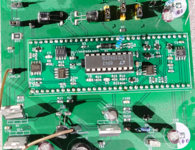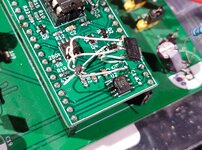In keeping with my latest string of recreations, here's another one.
I am working on recreating the 'hybrid module' from the non-backlit macintosh portable because these tend to die and do stupid things thanks to capacitor fluid damage or the coating cracking off of the high precision laser-trimmed resistors, etc.
This has been a multi-part effort.
First step was taking the available macintosh portable schematics, and using those to make a 'downstream' board which contains the various power components which are controlled by the hybrid module. So this PCB has mosfets, capacitors, resistors, battery and power supply hookups, etc. This way the recreation modules can be tested without breaking anything on a real portable.
Next, I depopulated a hybrid module from a portable that had been sitting in the desert for who knows how long (thanks @GeekyBit for selling this to me for such a good price). Remove components, measure resistor and capacitor values, trace the schematic, new board created.
This is my very much prototyping and in-progress setup (#blurrycam):

What's working so far:
* The primary 5v power rail (called 5V_AlwaysOn, now regulated to 5.25 volts)
* 12v downstream enable (turns mosfets on to allow power to the 12v generator chip)
* -5v downstream enable (turns on the -5 generator circuit which lives on the hybrid module)
* Battery charger
* Battery charge indicator signal
* Battery charge cutoff (HICHG, signal from the power manager chip to disable battery charging)
* Under-voltage cutoff (though it's at 5.4v instead of the 5.6 to 5.8 which is probably more correct)
Things which need more work and testing:
* -5v power rail is all over the place (-6 instead of -5)
* A/D feedback line to power manager (for battery charge level indication - this probably needs testing in a real portable)
* Under-voltage cutoff (as mentioned above, it's a little low but may be ok)
Hardest part about the hybrid module is all of the funky valued resistors. See all the multi-turn adjustable potentiometers on there? And the W-shaped chain of resistors at the bottom of the picture? Yeah. Need to try and find equivalents, or the final product will require micro-trim resistors to be sure the values are all right.
I am working on recreating the 'hybrid module' from the non-backlit macintosh portable because these tend to die and do stupid things thanks to capacitor fluid damage or the coating cracking off of the high precision laser-trimmed resistors, etc.
This has been a multi-part effort.
First step was taking the available macintosh portable schematics, and using those to make a 'downstream' board which contains the various power components which are controlled by the hybrid module. So this PCB has mosfets, capacitors, resistors, battery and power supply hookups, etc. This way the recreation modules can be tested without breaking anything on a real portable.
Next, I depopulated a hybrid module from a portable that had been sitting in the desert for who knows how long (thanks @GeekyBit for selling this to me for such a good price). Remove components, measure resistor and capacitor values, trace the schematic, new board created.
This is my very much prototyping and in-progress setup (#blurrycam):
What's working so far:
* The primary 5v power rail (called 5V_AlwaysOn, now regulated to 5.25 volts)
* 12v downstream enable (turns mosfets on to allow power to the 12v generator chip)
* -5v downstream enable (turns on the -5 generator circuit which lives on the hybrid module)
* Battery charger
* Battery charge indicator signal
* Battery charge cutoff (HICHG, signal from the power manager chip to disable battery charging)
* Under-voltage cutoff (though it's at 5.4v instead of the 5.6 to 5.8 which is probably more correct)
Things which need more work and testing:
* -5v power rail is all over the place (-6 instead of -5)
* A/D feedback line to power manager (for battery charge level indication - this probably needs testing in a real portable)
* Under-voltage cutoff (as mentioned above, it's a little low but may be ok)
Hardest part about the hybrid module is all of the funky valued resistors. See all the multi-turn adjustable potentiometers on there? And the W-shaped chain of resistors at the bottom of the picture? Yeah. Need to try and find equivalents, or the final product will require micro-trim resistors to be sure the values are all right.


